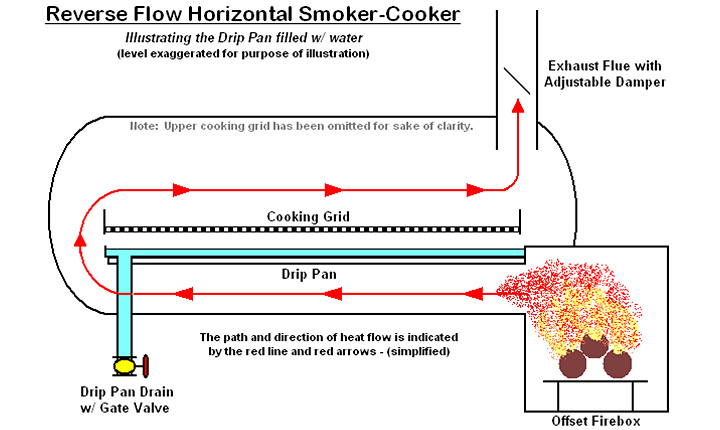Contents
We all love outdoor parties. If you wish to extend your social circle, they say there’s no better way than to invite friends for the best bbq dishes grilling in your backyard. A seasoned host will always know the relevance and ease of a reverse flow smoker.
If you wish to build your own offset smoker, you must begin with understanding what it is and how it works. In this article, we will guide you with the hows but let us begin with the whats. An offset smoker uses an indirect heat set up in BBQing.
The fire is offset, which means that the heat source of the smoker is kept sideways. It typically uses wood as a source of heat.
A reverse flow smoker takes the help of a baffle to circulate the air through the food chamber, and only after that does it allow it to be reversed or turned. This cooks your food evenly, and the chamber walls trap the heat longer.
Let us now dive right into how to build a reverse flow smoker and all its essential aspects.
Tools and Materials for Work

If you plan on building a reverse flow smoker, there are certain materials and tools that you must have. We have listed certain essential tools that you cannot do without if you have made up your mind about the DIY reverse flow smoker.
- Any kind of cooking chamber
- Firebox
- Baffle plate
- Smoker thermometer
- Angle fire for frame
- Heat high paint
- Shelf
- Wooden handle
- Vents
- Casters
- Hinges
- Smokestack
- Metal for grate
- Wielder
- Pliers
- Wire brush
- Chipping hammer
- Gloves
- Face shield
- Wielding shield
- Safety glasses
How to Build a Reverse Flow Smoker
Construction and Design Planning

There are certain considerations that you might wanna put in before you start constructing a homemade reverse flow smoker. The design and planning are very important.
Reverse flow smoker plans are made, keeping in mind the weight and portability you want. Whether you need to transport this equipment often or are you gonna keep it static at a place, the kind of crowd you shall be entertaining and the storage space you have are some major considerations that go into design planning.
It is going to be a heavy smoker and if you plan hastily, you might end up making a very useless one. Also, keep in mind the kind of tools and materials you have access to. If you do not have a certain material, what are the alternatives that can be used- small details like this one should also go into your considerations.
Making a Reverse Flow Smoker
The Cooking Chamber
You can use any appropriate material as your cooking chamber as long as it can accommodate enough quantity. Now put together some casters and a frame to bring together the whole thing.
Neatly cut a part of your chamber and, using some hinges, turn it into a door. Make sure that you seal the door in a way that no smoke escapes once it is closed. You may use some aluminum stock for it. Frame the gasket with some silicone as it may tend to get really hot.
Firebox
The steel firebox should be ideally oversized to cope with excessive heat. Make it into a square box and drill holes at the sides along with bolts to add the vent control. Make a door just like you should in the cooking chamber.
The firebox will be heavy, and thus it is wise to build it on a platform that can be moved around. Use bolts to attach your firebox to the smoker if you wish to make it removable.
Cooking Grate and Baffle Plate

The plate steel is used mainly to keep away direct heat. Once the heat escapes the firebox, it goes under the baffle plate and is redirected back until it finally escapes the chimney.
The Chimney
The chimney is perhaps the easiest part of building a reverse flow smoker. Use a ventilation pipe for the smoke to escape. Attach this to your smoker, and you are good to go.
Final Stages of Work
Before you are all ready to play the best host and show off the skills of your new DIY bbq, you must finish with the final touch and make sure it’s working.
Build a fire basket, for which you may use a mesh. This is where the hot coals and wood will go in. Mount a wooden handle to make it easier to use. Install thermometers and get rid of flux that is left over.
Final Word
We hope you are ready to build reverse flow smoker of your own. This DIY project is extremely adventurous and fun. However, make sure you are undertaking all safety measures while using tools and handling the materials.
If you are an amateur, go for a grill smoker combo or construct it under supervision. Let us know all about your experiences in the comment section.







